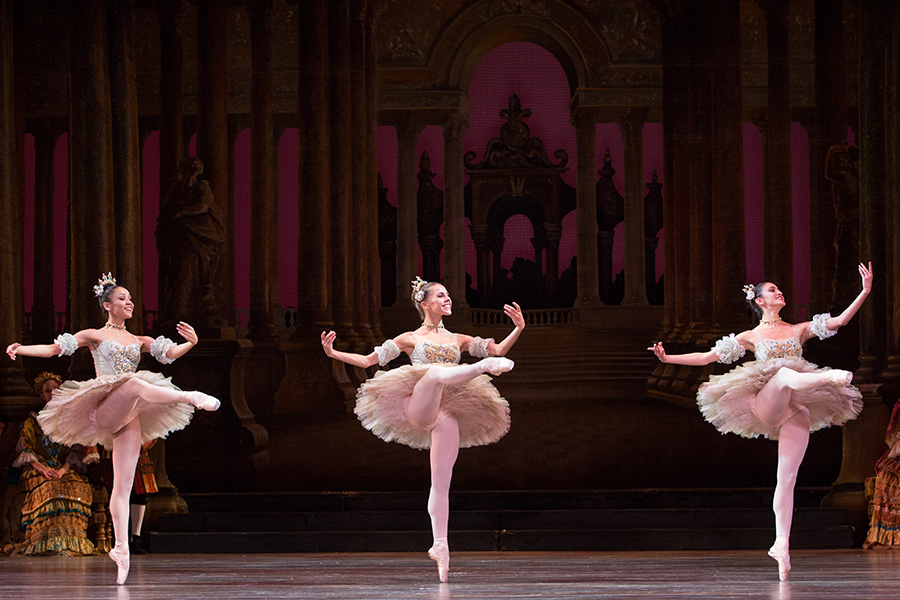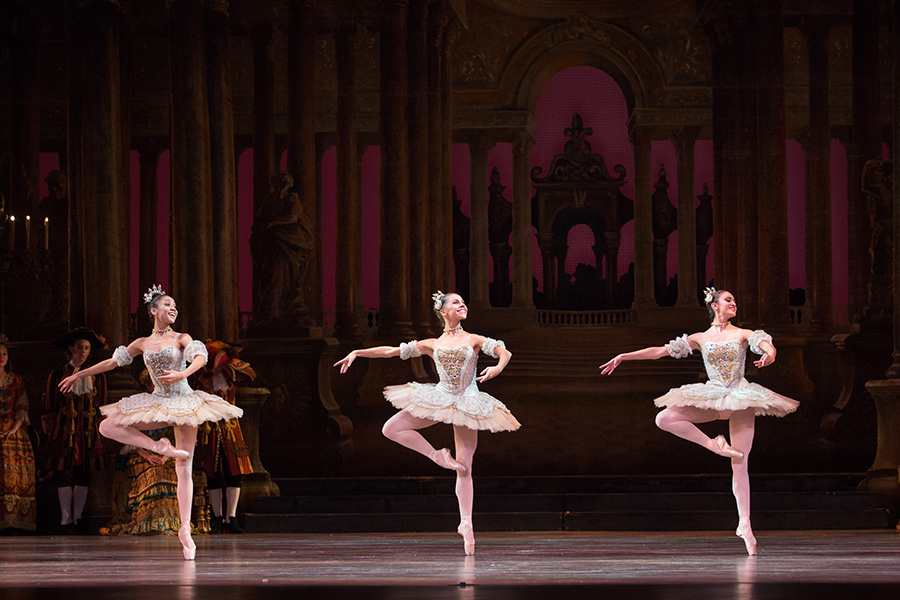This Stunning Performance of The Sleeping Beauty Manages to Make Ballet Entertaining for Any Philadelphian

Nayara Lopes, Alexandra Heier, and Ana Calderon of Philadelphia Ballet in “The Sleeping Beauty,” choreography by Angel Corella. Photo by Alexander Iziliaev.
With the right performance, there’s nothing like ballet’s ability to combine spectacular, live physical feats with a narrative that’s as engaging as any Hollywood hit. A great ballet dancer doesn’t possess just technical mastery–they tell an emotionally engaging story through a melding of acting and visually stunning performance.
Nayara Lopes, principal dancer at Philadelphia Ballet, says she’s taking that mindset into her dream role as Princess Aurora in Philadelphia Ballet’s upcoming production of The Sleeping Beauty.
“Ballet is not just dancing; it’s physical and mental. In a great performance, you cry and smile. You want the audience to feel what you’re feeling,” she says.
For Lopes, a rising star in ballet, it’s a culmination point for her work with Angel Corella, artistic director at Philadelphia Ballet. The pair’s creative partnership has presented performances that entrance new ballet-goers with exciting and engaging human stories, overturning expectations of those who have been wary of the seemingly complex art form.
“I think ballet, when you don’t know the technical terms or concepts, that’s actually when it’s the best,” Lopes says. “That way you can get caught up in this beautiful love story and performance instead of analyzing things too much.”
Lopes will have an opportunity with the upcoming performance to show her audience what that mindset can achieve, as The Sleeping Beauty will likely attract potential newcomers and long-time lovers of the Disney movie. (The production, which hearkens back to the original fairytale and features music by Tchaikovsky, will have both narrative and visual surprises for those viewers more familiar with the film.) We spoke to Lopes about what it takes to create excitement for all viewers through her performance, and how viewers can best appreciate the production from her perspective.
Video: Nayara Lopes and Artists of Philadelphia Ballet in “The Sleeping Beauty,” choreography by Angel Corella. Video by Alexander Iziliaev.
The Role of a Lifetime
The role of Aurora means a lot to Lopes.
“I think every ballerina wishes to play a princess like Aurora. You die [metaphorically] and come back to life, you get to marry a prince. I’m definitely fulfilling my dream,” Lopes says. “And when I get to take on a role like this, which is also a very technically demanding role, I think about everything I have done in my career that has allowed me to do this.”
The work tells a dramatic story through a complex and challenging performance, and it’s a chance for Lopes to display her full capabilities. It’s been a long road to acquire the talent needed to master the art form. Lopes came to the United States at sixteen years old from Brazil, with $200 to her name.
“I struggled for about four years, before I started to find success in ballet,” Lopes says. “And it’s taken me twenty years to get where I am now.” As a younger dancer, she took on the role of Aurora, but now as a more mature dancer, she feels that she is seeing and understanding the role in a new way.
“I’m going back to this role, but I know my capabilities better now,” Lopes says. “And I see so much more. I see so many more physical and emotional details that I couldn’t see when I was still learning. So it’s 40 times more challenging, but 40 times more rewarding.”

Artists of Philadelphia Ballet in “The Sleeping Beauty,” choreography by Angel Corella. Photo by Alexander Iziliaev.
Planning for Success
You can see that commitment in the way Lopes thinks and talks about the role. Her approach, physically and emotionally, evolves throughout the performance, changing as the character and story develops.
“I didn’t want her to be simply a pretty girl,” Lopes says. “I want her to be fully human. Sometimes I see on other stages, beautiful ballerinas that are just a little bit plastic, and they are not playing the role. I want to make it relatable, in addition to being technically impressive.”
Lopes, who prepares for the ballet in eight-to-nine hour days, begins that process by training to execute Corella’s masterful choreography exactly. But as that work is completed, she takes creative lead on giving her character full expression.
“Closer to the show, about two weeks before, when we trust our technique and it’s in our body, they always say, now the ballet is yours,” Lopes says. “Now you can present the character’s personality and point of view, where you choose how to reveal what she’s feeling.”

Nayara Lopes, Alexandra Heier, and Ana Calderon of Philadelphia Ballet in “The Sleeping Beauty,” choreography by Angel Corella. Photo by Alexander Iziliaev.
Putting It Into Action
It’s not just how she talks about the role–you can see her thoughtfulness in her performance. The production is divided into three acts, and each act showcases a new combination of technical feats and a change in tone and character.
The first act portrays Aurora as a sixteen-year-old girl attending the party that will lead to her falling under a spell (by an evil fairy named Carabosse, not Maleficent as in the Disney version). It’s a high energy, joyful first act, full of fast movement and leaping, that also requires Lopes to get into the cheery mindset of a teenager.
“She comes from a rich family and it’s a big, energetic surprise party with lots of corps de ballet, which is the most difficult part of the ballet. A lot of light, a lot of difficult steps, a lot of lifting,” Lopes says. “And I wanted to play her as real as possible. Which is why this role can be challenging–you need to have a mature, expert dancer with strong muscles, but you also need to portray a young woman.”
With the second act, which begins with Aurora under the spell, the lights darken and the production takes on a more dream-like and carefully paced tone, a space where Lopes can pull back and present a full display of her technique. It’s also a transition point for her as an actor, as Aurora wakes up from the spell heading into the third act as an older, more mature woman. Her role culminates in a grand wedding, where the audience notes a change in the physical feel and look of her performance.
“Everything is more solid, more mature, more elegant,” Lopes says. “The audience falls in love with the wedding because the movement is so charming and chic.”

Nayara Lopes, Alexandra Heier, and Ana Calderon of Philadelphia Ballet in “The Sleeping Beauty,” choreography by Angel Corella. Photo by Alexander Iziliaev.
The Complete Vision
Lopes notes that the magic of the production extends beyond her own role. Throughout, details from the original fairy tale add exciting and even comic surprises. One scene of a fairy tale village features classic characters from a wide range of stories, from Little Red Riding Hood to Puss in Boots. Dream scenes and multiple fairies create stunning visuals that will be a little unlike anything viewers have seen elsewhere. And Lopes points to Corella’s careful decisions in keeping audiences engaged–he’s trimmed and structured the play with a focus on conveying a driving narrative to all viewers.
The effect is that viewers of all kinds can enjoy Lopes’ dream role as much as she herself does.
“The audience should expect something beautiful and magical, a story of falling in love,” Lopes says. “Everyone is going to be caught up in the excitement of it.”
This is a paid partnership between Philadelphia Ballet and Philadelphia Magazine